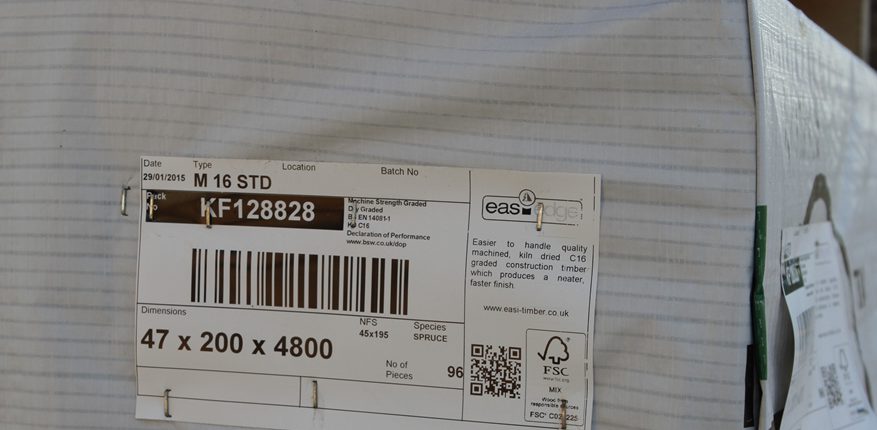Storing timber on site
Wood Campus Timber Trade Topics are produced in collaboration with Timber Development UK. For further information, visit
https://timberdevelopment.uk/.
TOPIC CHECKLIST
- Plan deliveries of factory-finished products to be ready when you want to install them
- Keep all timber products protected from rain, surface water and sunlight
- Before work on the site begins, consider the type and size of indoor or undercover storage you might need
- Check the moisture content of your timber products on delivery and report to your supplier if they don’t comply with the specification
- Check products have been properly covered for transit from the factory or supplier, and there is no evidence of damage
- Use the correct mechanical handling gear for unloading and storage and avoid edge damage, common on sheet materials
- Leave any existing protective coverings in place
- Ensure wet trades have finished before installing timber
- Make sure the building is adequately ventilated throughout the process
- Where there are openings, such as windows and doors, have them glazed or covered, even if only as a temporary measure temporary before final fitting
Carcassing timber
All timber, even carcassing, benefits from good covering and storage. If you have to store carcassing outside:
- Store on dry, even ground that doesn’t hold water
- If possible, spread the area with gravel or sand
- To help prevent warping with changing conditions, stack the timber flat on equal sized bearers of, say 75mm x 75mm. Put one bearer towards each end of the timber and one in the middle
- Use a waterproof cover over the timber, but allow air circulation around the timber. This will not only keep it dry but will also protect it from direct sunlight, which could warp the timber
Some of the problems that can result from poor site storage:
- Increased wetting of the timber leading to a higher moisture content
- Defects occurring in the timber because of this, shrinkage etc. leading to the product being unfit for purpose
- Damage to metal fixings, for example metal plates on roof trusses
Joinery or manufactured and factory-finished timber products
These products, such as windows and doors, are expensive and can be easily damaged. Typically delivered direct from the factory ready for installation, these products will have been manufactured to a precise moisture content and wrapped to protect the finish. Take extra care when storing them under cover:
- Without unwrapping the product, check there has been no damage on delivery
- Where possible, store in a well ventilated area, preferably the building they are to be installed in once the building has properly dried out
- If this isn’t possible, use well ventilated temporary storage, such as a garage or large shed with some form of heating control to maintain the factory moisture content
- Store vertically, taking care to avoid damage caused by the ironmongery
- Store in the order you’ll be using the product
Sheet Materials
- Preferably store in similar conditions to factory finished products
- Do not store interior quality sheet materials outside
- If possible, always store flat on equal sized bearers positioned at maximum 600mm centres. This will help to keep the sheets level, and away from direct ground contact
- Keep bearers horizontally aligned to avoid any distortion of the boards
- If storing materials thinner than 6mm, use a thicker sheet of material, say 18mm, under them to provide additional support
- When storing large numbers of sheet materials, split them up into 10-15 boards, sticked in line with bearers. This will provide even more protection against distortion, especially if they are not going to be used quickly
- When using factory-finished and speciality sheet materials indoors, try to store them as described for a minimum of 48 hours in the dried-out building they are going to be fixed in

Moisture Content
A timber product should arrive on site with the right moisture content. Changes to moisture content can give you all sorts of problems. Make sure you:
- Check the timber’s moisture content’s right on delivery
- Store timber products inside the building where they are going to be used
- If this isn’t possible, try and provide good quality temporary covering
- If you have to store timber products outside, under cover, make sure there is adequate ventilation to help prevent changes to moisture content
- Be cautious when storing timber products in newly plastered buildings or near newly concreted floors, as the moisture in the atmosphere could be high. Try and wait until the building has dried out. Use temporary storage in this case – a garage or shed, but make sure it has good ventilation
Roof trusses and structural timber components, e.g. I-joists
- As these are bulky items, schedule site deliveries so that you are using the products as soon after delivery as possible
- Store vertically with trestle support and bearers underneath the metal connecting plates
- If you have to store horizontally, ensure you use evenly-sized timber supports to keep them off the ground placing them underneath each truss node
- Cover and protect as previously described
- Take care to only lift trusses at the designated fixing points
- Once fixed to form the roof, cover with felt as quickly as possible to provide additional protection
Timber Frame Panels
- Make sure these factory-engineered components are stored side up on equal sized bearers at even intervals
- Cover and protect as previously described
Certified products
- Try and store separately from your other site products to allow easier identification of the product
- If you are project managing, ensure that they have a valid chain of custody certificate

| Use | MOISTURE CONTENT |
|---|---|
| Carcassing timber | 22% |
JOINERY | |
| Internal – unheated buildings | 12 - 16% |
| Internal – buildings heated to 12 – 21°C | 9 - 13% |
| Internal – buildings heated to over 21°C | 6 - 10% |
| External | 12 - 19% |
| FLOORING TIMBER* | |
| Softwood structural | 18% |
| Softwood and hardwood decorative | 10 - 12% |
| With underfloor heating** | 8 - 10% |
*May only be available by special order. Pay special attention to maintaining moisture content.
**Seek manufacturer’s advice for buildings with continuous or underfloor heating.


Sustainable timber
Timber is the most sustainable mainstream building product. It is naturally renewable. Over 90% of timber used in UK construction comes from Europe, where more trees are grown than harvested (source: TTF Statistical Review 2016).
Softwood and temperate hardwood forests in Scandinavia, Europe, Canada and North America are stable or growing. Growing forests act as carbon sinks; wood products act as carbon stores.
Ask for PEFC or FSC Chain of Custody certification.
See Wood Campus RIBA CPD module Procuring Sustainable Timber for more on timber certification and sustainability and government requirements.



